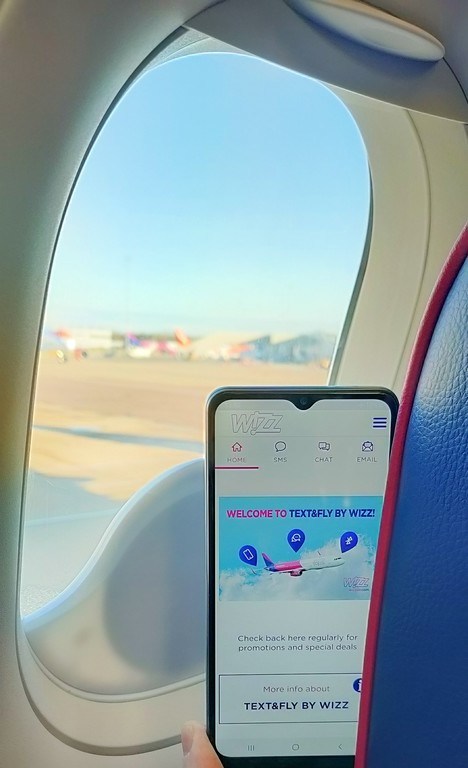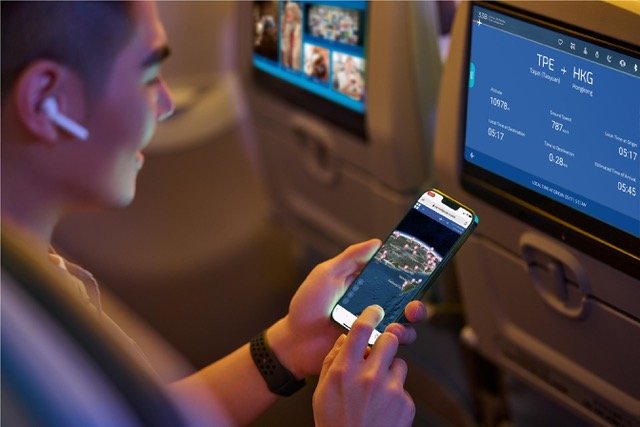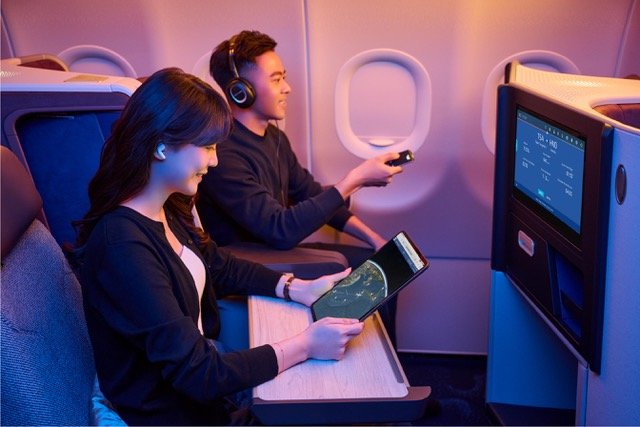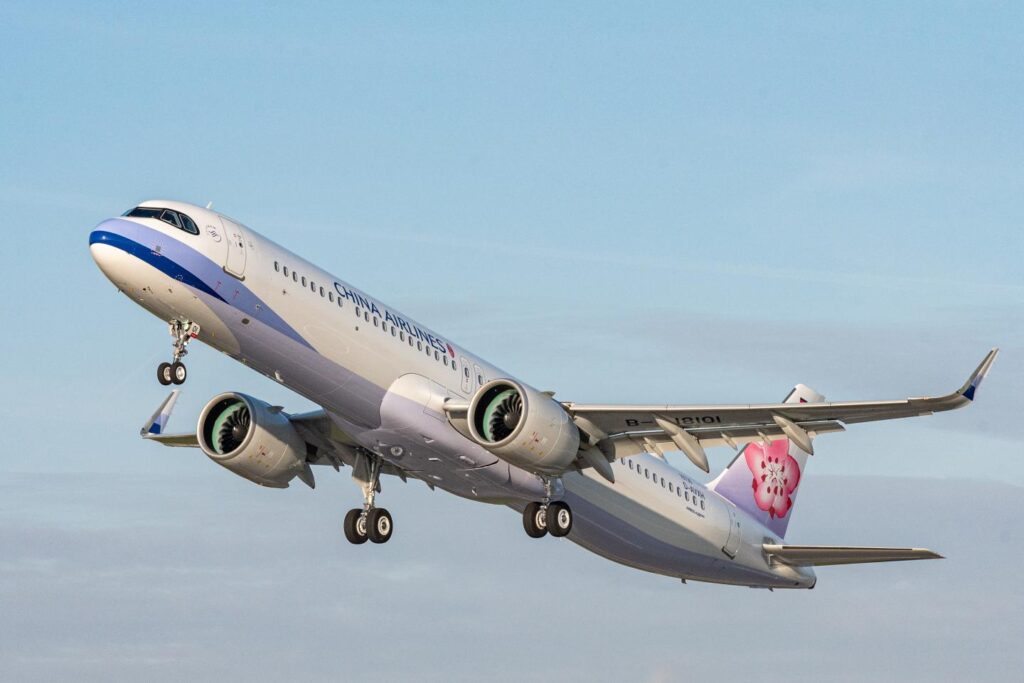
Wizz Air to Add fflya In-Flight Connectivity to UK Fleet

Wizz Air, the Hungarian low-cost airline, is adding in-flight connectivity to its U.K.-based fleet of Airbus A320 and A321 aircraft under a new agreement with AS-IP Tech, Inc.
Under the new agreement, Wizz Air will integrate AS-IP Tech’s fflya Bluetooth platform into its mobile app and provide free SMS, WhatsApp messaging, and email to its passengers. According to AS-IP Tech, their system is enabled by installing one single Bluetooth wireless access point and two window-mounted antennas affixed to both sides of the aircraft.
According to an update on the technology shared by AS-IP Tech in November, some Wizz Air passengers have already been using the technology on U.K.-based A320 and A321 routes operated by the airline. Although AS-IP Tech provides very little details bout how its technology works, their antennas and Bluetooth access points leverage connectivity provided by the Iridium Next satellite network.
In addition to passenger connectivity, fflya also transmits operational telemetry data from the A320 and A321 fleet operated by Wizz Air. Wizz Air is promoting the upgrades to its U.K.-based fleet as “TEXT&FLY BY WIZZ.”
“Following months of successful flight testing, we are delighted to be selected by Wizz Air pioneering our new generation of in-flight connectivity,” ASIP Tech President Ron Chapman said. “We look forward to working with WIZZ and building on our unique messaging technology that provides the foundation for enhanced services including, inflight live payment, real-time telemetry and E Commerce.”
The connectivity and messaging services will be provided free of charge to customers, according to Wizz Air.

China Airlines Adds Second Screen 3D Moving Map Technology to A321neo Fleet

China Airlines is adding FlightPath3D’s “any device, any platform” three-dimensional second screen technology to its Airbus A321neo fleet, according to a June 8 announcement from the California-based provider of in-flight entertainment (IFE) technologies.
The “any device, any platform” from FLightPath3D is being added as a mobile device extension to the Safran seatback IFE system featured on China Airlines’ A321neo aircraft as part of the Chinese carrier’s plan to offer the same in-flight experience for passengers across its A321neo, A330-300, and B737-800 cabins. Jeremy Chang, Vice President of China Airlines’ corporate development office, describes FlightPath3D’s technology as the “the most advanced 3D map available.”

“FlightPath 3D’s engaging moving map technology on our second screen, plus the flexibility to add the kids’ app on our IFE, shows FlightPath3D’s ability to work with us to drive our initiatives of providing the best inflight experience for all passengers,” Chang said.
China Airlines operates a combined fleet of 86 aircraft, including 64 passenger jets and 22 freighters. There are five total A321neo aircraft currently being operated by the airline under a previously announced order for 25 neo aircraft placed with Airbus. The airline received its first A321neo on lease from Air Lease Corporation (ALC) in November.

FlightPath3D describes its moving map technology on Wi-Fi-enabled mobile devices as being capable of allowing passengers to “roam in a fully 360 degree horizontal by 180-degree vertical landscape.” The company has expanded the features included with its 3D moving map technology, including geographical points of interest, a content management system, shopping micro-sites, and a range of other ancillary revenue applications as well.
“China Airlines recognizes the second-screen experience is essential to captivate passengers and keep them engaged throughout their travel experience,” FlightPath3D President Duncan Jackson said, commenting on the new announcement. “Having a full, 3D map in your hand while watching a movie on your seatback is a game-changer for the passenger, and opens the doorway for innovative opportunities for the airline to reach its customers.”

Airbus is Conducting R&D on Optical Satellite Links for Ground, Aircraft, and Other Satellites

By Jeffrey Hill
Airbus Americas Vice President of Research and Technology Amanda Simpson confirmed Friday that the manufacturer is conducting research on inter- and intra-satellite optical link technology with universities in California.
During a speech at the Connected Aviation Intelligence Summit in Reston, Virginia, Simpson told attendees that she had just returned from a trip to visit Airbus’ research partners to learn about the latest developments in strengthening satellite communication signals to ground systems, aircraft, and other satellites.
“This is all about making automation possible,” said Simpson. “Today’s cockpit is already very automated, but Airbus sees the future of aviation relying much more heavily on AI and machine learning for more decision-making during flight. This added autonomy involves AI making choices based on data that may not give us the same result every time. This creates a question that is challenging to answer — How do you learn to trust that algorithm?”
Airbus has several research partners in California, including the University of Southern California, with which it partnered to establish the Airbus Institute for Engineering Research (AIER) in 2013. The Institute is based at the USC Viterbi School of Engineering.
Simpson, who also serves on the American Institute of Aeronautics and Astronautics’ Systems Engineering Technical Committee, said Airbus and its research partners are exploring new methods on how to strengthen secure bandwidth connections within next-generation satellites and to and from other ground and aviation systems.
“We’re looking at direct optical links between satellites,” she said. “Laser communications between satellites are limited to the strength of the signal. But we’ve been looking at phase modulation for the beams in order to increase the power of that signal. We’re also conducting research on how that would work in the atmosphere.”
In addition to working with universities, Simpson said Airbus is working with certifying agencies around the globe to establish trust in satellite-powered AI and ML applications. “I’m not just talking about aircraft,” she said. “We want to connect helicopters and satellites and we want to trust that those connections work securely.”
Airbus Americas serves as the U.S. arm of its Airbus S.A.S parent company based in France. The division is central in the development of Airbus’ Unified Airbus Network Solution, which is designed to utilize satellite data and networking technologies to help reduce airlines’ operating costs. Airbus sees autonomous flight as the key to fuel cost savings and operational efficiencies for airlines, supporting pilots in strategic decision-making and mission management.
Simpson joined Seneca Giese, director of Business Development at Cirrus Aircraft and Francesca Stockton, Aviation Connectivity product manager for Verizon Robotics, at the event for talks about its next-generation technology development plans.
Cirrus Aircraft has long been a customer of Iridium Communications, which powers its Cirrus Global Connect service, providing worldwide weather, satellite phone and text messaging services to the aircraft cabin. In January 2020, Cirrus released its Cirrus IQ app, which gives aircraft pilots the unique ability to check the status and performance of their aircraft remotely from their smartphone with a globally accessible digital connection. Cirrus IQ provides pilots with pre-flight status information, including fuel and oxygen levels, battery voltage, oil temperature, aircraft location, and flight hours.
Verizon Robotics acts as a connectivity use case factory for the aviation world. It is developing technologies and mixed fleet robots that create maps from drone data and provide autonomous navigation capabilities. In October, Verizon Robotics’ cellular carrier parent company announced it formed a collaborative partnership with Amazon to expand the carrier’s rural 5G and 4G LTE networks via Amazon’s upcoming Project Kuiper constellation.


